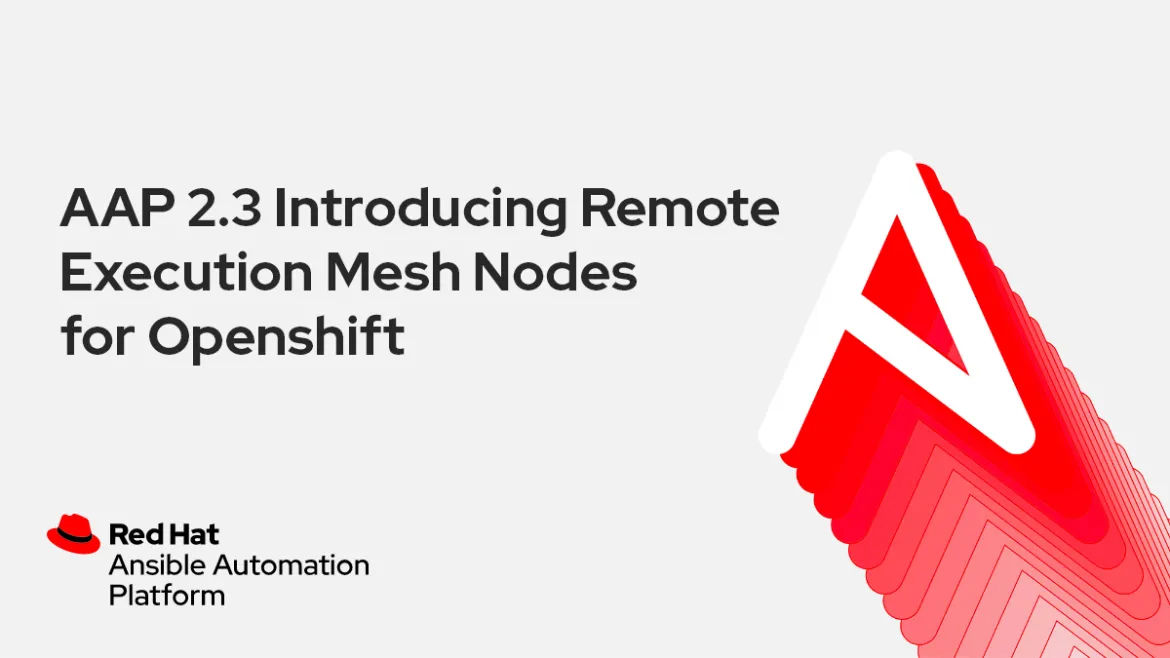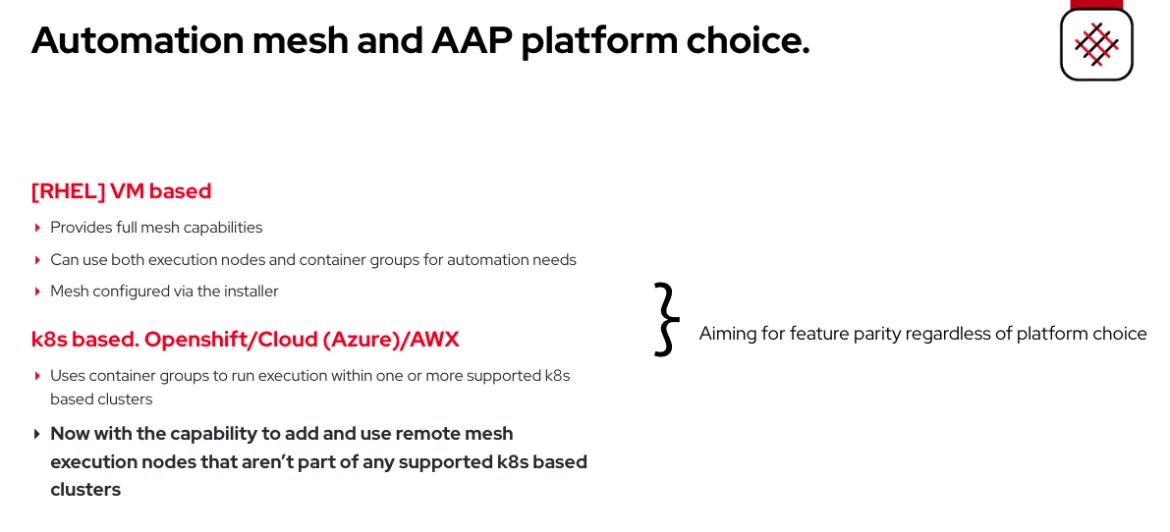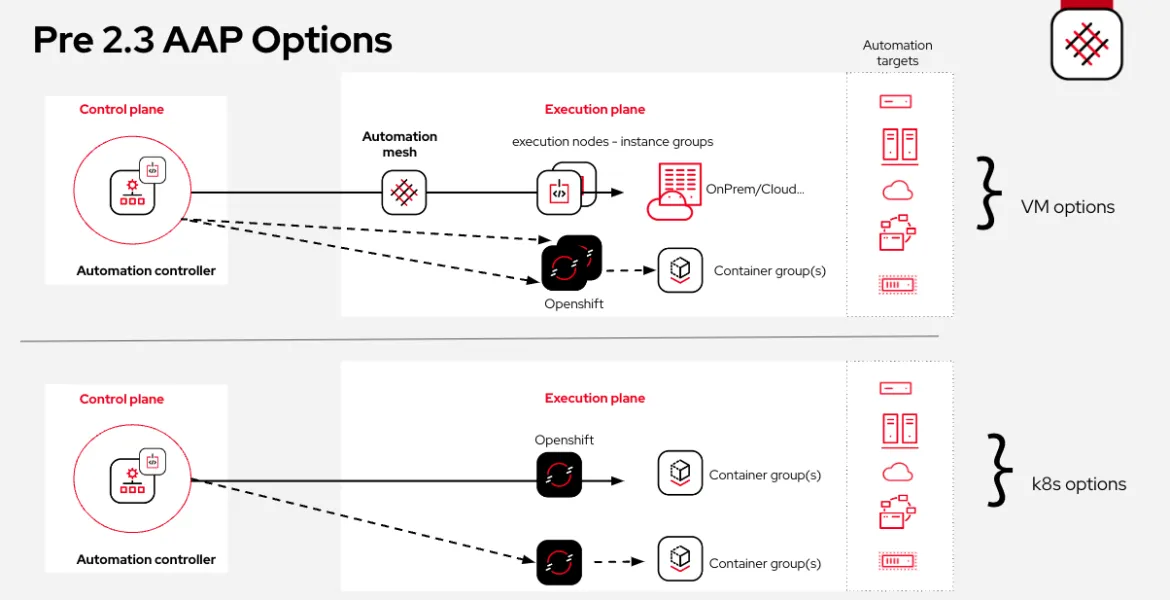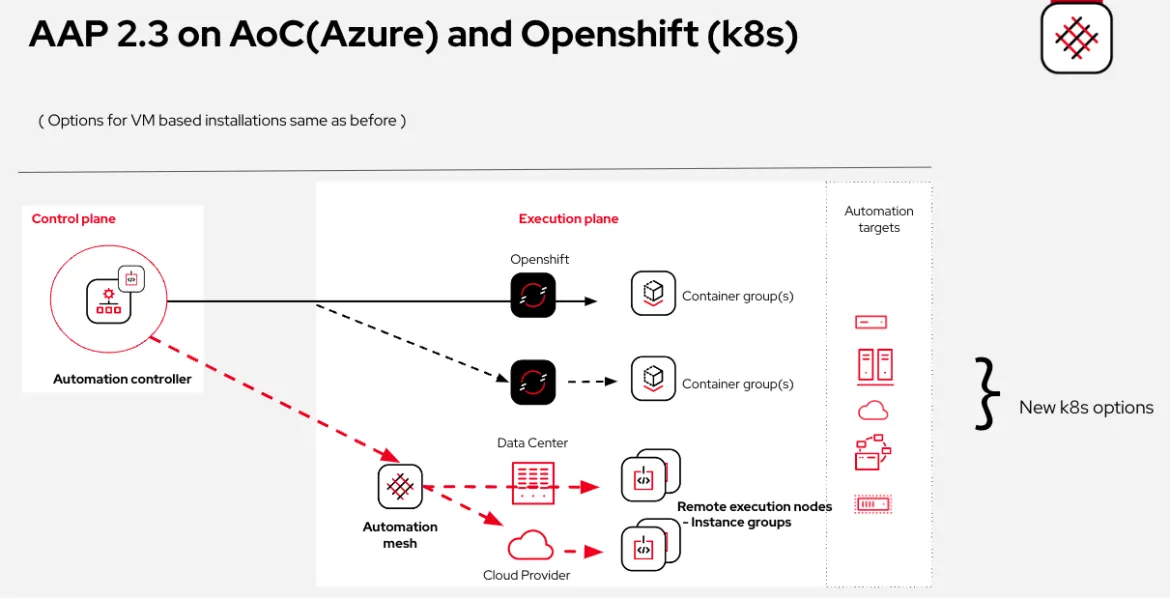
Last year Ansible Automation Platform (AAP) 2 introduced major changes around the mechanics on how automation is run. The main focus was to enhance the foundational pieces of the platform while providing flexibility and simplicity for automators to automate at enterprise scale. One of those foundational pieces introduced was automation mesh.
Automation mesh provides a simple, flexible and reliable way to scale automation of large inventories across diverse network topologies, platforms and teams. It was important to evolve how the platform was developed, managed, operated to meet business demands and needs, for the large majority of customers.
Pre 2.3 Automation Mesh in OCP
Prior to AAP 2.3, the automation mesh was mostly a VM deployment base option and feature. I’ve tried to highlight the main differences between platform choices in this diagram:

We are now starting to level up the feature parity, and this brings remote mesh execution nodes to non-VM supported deployments. Before we look more at the new feature, let’s look at the options that were available before:

For VM based deployments, the automation mesh introduced horizontal scaling, the ability to scale your automation needs out, whether locally or globally. We did this by installing execution and hop nodes where we needed them, to allow us to wrap new style automation around the existing instance group functionality.
For non-VM based deployments, such as those running on Red Hat OpenShift, you could only target automation using container groups, which made use of the Kubernetes API to create dynamic containers for runtime automation.
This was fine if that was all you needed, were all in on the kubernetes cloud native approach, but left a gap if you needed a more traditional, hybrid configuration, so allow you to run workloads in different locations or environments.
2.3 Automation Mesh in Red Hat OpenShift

In order to remove this limitation, in AAP 2.3 we have now released in Tech Preview, the ability to add remote mesh execution nodes. This is in addition to the use of the existing container groups.
NOTE: While we have added remote mesh execution nodes, hop nodes are not currently supported. We are working to add this further enhancement during a future release.
During AnsibleFest 2022, our very own controller lead engineer Hao Liu presented a virtual session around adding remote execution nodes when running AAP within a Red Hat OpenShift cluster. The virtual session is free and available on demand and includes more detailed content on how to successfully add remote execution nodes.
In summary
Red Hat Openshift now has the ability to use both container groups and remote execution nodes for automation, which:
- eases resources on the control plane (uwsgi, task manager).
- enables scaling beyond the cluster(s).
Integrate your Red Hat OpenShift AAP deployment with external execution nodes hosted anywhere/any environment:
- on premise data centers.
- cloud providers.
- edge deployments.
What can I do next?
Whether you are beginning your automation journey or a seasoned veteran, there are a variety of resources available to help you get the most out of your automation with Red Hat Ansible.
- If you’re looking for some additional context on the 2.3 release, you can register for our free webinar, “Ansible Automation Platform 2.3: Flexible, trusted automation at scale.”
- Watch the on-demand AnsibleFest 2022 session detailing the adding of remote execution nodes to an AAP on Red Hat OpenShift cluster
- Get hands on with on-demand self-paced exercises - We have a variety of interactive in-browser exercises that have been built to help you dive into directly Ansible Automation Platform.
- Trial subscription - Are you ready to install on-premises? Get your own trial subscription for unlimited access to all the components of Ansible Automation Platform.
- Developer license - Did you know that you can get a free developer license to learn in your home lab? Register and get access to all the latest tools, technologies and community that Red Hat has to offer.
- Subscribe to the Ansible Automation Platform YouTube channel.
- Follow Red Hat Ansible Automation Platform on Twitter - Do you have questions or an automation project you want to show off? Tweet at us!
À propos de l'auteur
Phil Griffiths is a Product Manager for Ansible Automation Platform with nearly seven years of experience at Red Hat. Phil has held roles as a solution architect and technical consultant both at Red Hat and for other organizations.
Contenu similaire
Parcourir par canal
Automatisation
Les dernières nouveautés en matière d'automatisation informatique pour les technologies, les équipes et les environnements
Intelligence artificielle
Actualité sur les plateformes qui permettent aux clients d'exécuter des charges de travail d'IA sur tout type d'environnement
Cloud hybride ouvert
Découvrez comment créer un avenir flexible grâce au cloud hybride
Sécurité
Les dernières actualités sur la façon dont nous réduisons les risques dans tous les environnements et technologies
Edge computing
Actualité sur les plateformes qui simplifient les opérations en périphérie
Infrastructure
Les dernières nouveautés sur la plateforme Linux d'entreprise leader au monde
Applications
À l’intérieur de nos solutions aux défis d’application les plus difficiles
Programmes originaux
Histoires passionnantes de créateurs et de leaders de technologies d'entreprise
Produits
- Red Hat Enterprise Linux
- Red Hat OpenShift
- Red Hat Ansible Automation Platform
- Services cloud
- Voir tous les produits
Outils
- Formation et certification
- Mon compte
- Assistance client
- Ressources développeurs
- Rechercher un partenaire
- Red Hat Ecosystem Catalog
- Calculateur de valeur Red Hat
- Documentation
Essayer, acheter et vendre
Communication
- Contacter le service commercial
- Contactez notre service clientèle
- Contacter le service de formation
- Réseaux sociaux
À propos de Red Hat
Premier éditeur mondial de solutions Open Source pour les entreprises, nous fournissons des technologies Linux, cloud, de conteneurs et Kubernetes. Nous proposons des solutions stables qui aident les entreprises à jongler avec les divers environnements et plateformes, du cœur du datacenter à la périphérie du réseau.
Sélectionner une langue
Red Hat legal and privacy links
- À propos de Red Hat
- Carrières
- Événements
- Bureaux
- Contacter Red Hat
- Lire le blog Red Hat
- Diversité, équité et inclusion
- Cool Stuff Store
- Red Hat Summit

